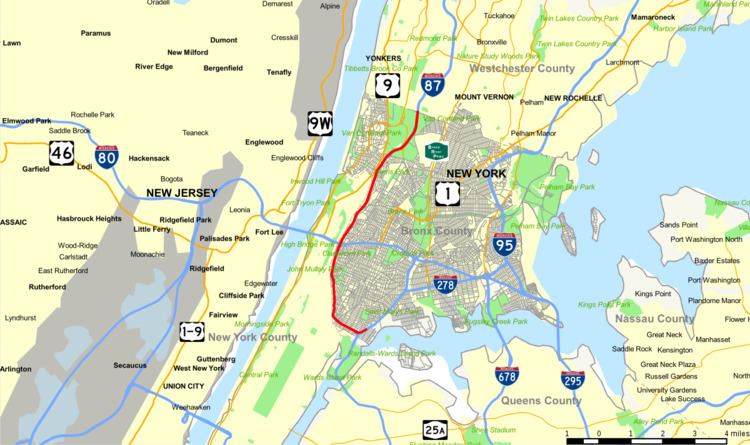Existed: April 1939 – present South end: I-278 in the Bronx Constructed April 1939 | History: Completed in 1956 Length 14 km | |
 | ||
North end: I-87 / New York Thruway at the Westchester County line | ||
New york interstate 87 north major deegan expressway mile marker 0 to 9
The Major Deegan Expressway, officially named the Major William Francis Deegan Expressway and locally known as the Deegan, is a north–south expressway in the New York City borough of the Bronx. It is the southernmost 8.70 miles (14.00 km) of Interstate 87 (I-87), beginning at I-278 at the interchange of the Bruckner Expressway and the Triborough Bridge in the south Bronx and ending at the Westchester County line in Yonkers, where the New York State Thruway begins. In between, the Major Deegan Expressway winds through Van Cortlandt Park, intersects with I-95 (the Cross Bronx Expressway) near the George Washington Bridge, and passes by Yankee Stadium on its eastern flank.
Contents
- New york interstate 87 north major deegan expressway mile marker 0 to 9
- Map of Major Deegan Expy New York USA
- Major deegan expressway interstate 87 northbound
- Route description
- History
- Exit list
- References
Map of Major Deegan Expy, New York, USA
The expressway was completed in 1956 and became part of I-87 when that highway was assigned as part of the creation of the Interstate Highway System in 1957. It is named for William Francis Deegan, who died in 1932. He was an architect, a Major in the Army Corps of Engineers and a Democratic political leader in New York City.
Major deegan expressway interstate 87 northbound
Route description
The Major Deegan Expressway begins at an interchange with the Bruckner Expressway (I-278) in the South Bronx. The route heads northwestward from the junction, loosely paralleling the Harlem River as it carries I-87 through Mott Haven. After 1 mile (1.6 km), the highway makes a turn to the north, mirroring a change in the nearby river's course. It passes by Yankee Stadium on its way to Highbridge, where the Deegan connects to the Cross Bronx Expressway (I-95 and U.S. Route 1 or US 1) at the eastern approach to the Alexander Hamilton Bridge. The Deegan remains in close proximity to the Harlem River until the waterway turns westward at Kingsbridge to form the northern edge of Manhattan.
North of Kingsbridge, I-87 and the Major Deegan Expressway follow a generally northeasterly alignment, passing through the center of Van Cortlandt Park as it connects to Mosholu Parkway and Jerome Avenue. Mosholu Parkway also links the Deegan to the Henry Hudson and Saw Mill River parkways, which run parallel to the Major Deegan Expressway through the western Bronx and Manhattan. Past Jerome Avenue, the freeway gains a pair of service roads and heads north to the New York City line, where it becomes the New York State Thruway as it passes into Westchester County. The last northbound exit on the Deegan connects to McLean Avenue, located north of the city line in Yonkers. The exit 14 ramp leads to the service road in the Bronx but does not meet McLean Avenue until it crosses the county line. Southbound access to McLean Avenue is provided by Thruway exit 1 in Yonkers.
History
The origins of the Major Deegan Expressway date back to 1936 when the Regional Plan Association concluded that in order to relieve New York City's traffic problems, a limited-access, truck-accessible expressway should be built on the west side of the Bronx. This route would connect the brand-new Triborough Bridge to the proposed New York State Thruway in Westchester County. A 1.5-mile (2.4 km) section of the expressway from the bridge to the Grand Concourse was completed in April 1939. The highway was adorned with Whitestone-style light posts placed every 75 feet (23 m) of the 6-lane highway, each of which were 12 feet (3.7 m) in width. The expressway was designated as New York State Route 1B (NY 1B) c. 1941; however, the designation was removed by 1947.
In 1945, public works planner Robert Moses proposed extending the highway to the proposed Thruway. Construction on the extension began in 1950, and the new route was opened in 1956. The Deegan became part of I-87 when that highway was assigned as part of the creation of the Interstate Highway System in August 1957.
In the wake of former New York Yankees player Joe DiMaggio's death on March 8, 1999, Governor George Pataki proposed renaming the Deegan Expressway to the "Joe DiMaggio Highway". However, New York City Mayor Rudy Giuliani favored renaming the West Side Highway for DiMaggio instead. Pataki agreed to Giuliani's proposal one week later.
On January 4, 2014, a "single-engine fixed-wing Piper PA28" made an emergency landing on the expressway, near exit 13.
Exit list
The entire route is in the New York City borough of The Bronx.
